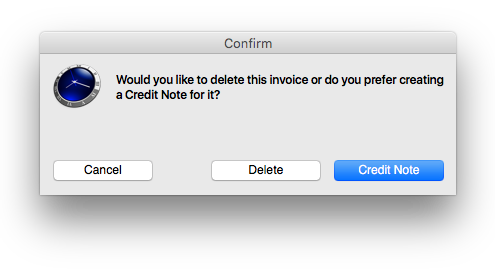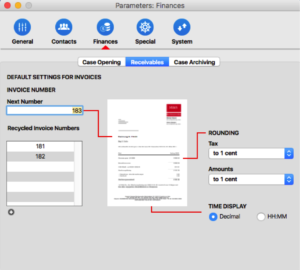How Can I Make Sure That My Invoice Numbers Are Compliant With Regulations?
As long as an invoice is saved under "unprinted invoices" it will be considered a temporary draft. If you delete the invoice, its number will be released and reassigned to the next invoice. Therefore, you can always delete a draft invoice and recreate it: the assigned number should remain the same.
Delete or Credit an Invoice?
Once an invoice is finalized and saved as "outstanding invoice", its number will no longer be available. If you delete one of these invoices, you can either credit the amount (Credit Note) or delete it. You will see the message pictured on the right.
For transparency reasons, it is often advisable to credit the amount. There may be cases where a credit note does not make sense.
Let's assume you create and send a retainer invoice for a new client. Should this client change his mind and retain the services of another lawyer, you may as well spare the effort of creating a credit note and just discard the invoice.
Even under German compliancy rules, it is not necessary to have a continuous numbering for all invoices. However, each number may only be assigned once.
In the above-mentioned example, in order to ensure internal traceability, you may want to create a PDF copy of the retainer invoice and add it to a case memo. You will find the invoice in your document archive.
You will find more information regarding accounting here.
Modify Invoice Numbers
Go to "Settings", "Parameters", then select "Finances". You can modify the invoice number under the tab "Receivables". You may want to increase the starting number if you do not want to disclose the actual number.
You can also access all the "recycled" invoice numbers. Usually, there is no necessity to manage these manually, as timeSensor LEGAL does this automatically.
Related Articles
Avoiding Gaps in Invoice Numbers
Avoiding Gaps in Invoice Numbers By default, timeSensor LEGAL behaves in such a way that when unprinted invoices are deleted, the corresponding invoice number is returned to an invoice number pool and then reused. However, if a printed invoice is ...How are my invoice numbers correct vis-à-vis the tax authorities?
This article has been machine translated. If you find any errors, we would be grateful if you could report them to translation@timesensor.com. In timeSensor LEGAL, an invoice is considered provisional as long as it is still in the unprinted invoices. ...Why is an advance not automatically credited to an invoice?
When an advance invoice is created, it is necessary for it to be printed in order to be successfully placed and archived. On the other hand, it must be booked as paid to be credited to an invoice. Nevertheless, this may not happen automatically. You ...How does archive division work in the mandate?
Problem: An invoice was created in the Max Muster file, which is automatically included under attachments oppositewas. Explanation: An archive division is stored in the mandate, which has now been deleted. In this archive classification, the box ...How do I update the invoice date of unprinted invoices?
If you create an invoice with timeSensor LEGAL, it initially remains in the list of unprinted invoices . timeSensor LEGAL itself can also automatically create invoices and these also appear in the unprinted invoices . If you do not print these ...

